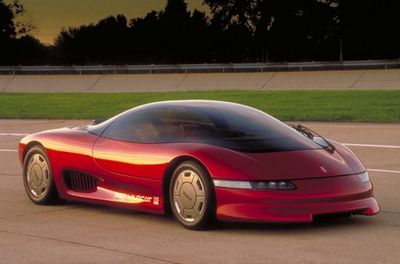2015 Detroit Auto Show: Buick's Influential Five
 1985 Buick Wildcat Concept |
Concepts that drove the brand’s design and technology; inspired the industry
DETROIT -- January 11, 2015: Buick’s all-new Avenir concept, introduced today ahead of the North American International Auto Show, advances a legacy of progressive concepts that stretches back to the 1938 Buick Y-Job, the industry’s original concept vehicle.
Like its predecessors, the Avenir blends exploratory styling with advanced technology to probe new directions for Buick and test features that may transfer to future production models.
“Buick, under the design leadership of Harley Earl, created the industry’s first concept vehicle and for more than 75 years each new Buick concept has pushed the brand forward and influenced the industry through great design,” said Ed Welburn, vice president of General Motors Global Design. “From designs that push the boundaries of graceful, elegant proportions and progressive interior designs, Buick’s concepts have always inspired with the relevance of a future that is not too far away.”
Here’s a look at five of the most influential concepts that advanced Buick’s design, driver technology or powertrain technology:
1. Y-Job (1938)
Considered the
industry’s first true concept car, the Y-Job was developed by Harley
Earl, GM’s first design chief. It was designed solely to gauge the
public’s response to the innovative styling and features rather than
foreshadowing a new production model. The media immediately hailed the
Y-Job as the “Car of the Future.” In many ways it was, as it
previewed features that would become common throughout the industry,
including power windows, flush-mounted door handles, disappearing
headlamps, a concealed convertible top and more. The sleek roadster is a
landmark of automotive design and represents the blueprint for concept
vehicle design and execution.
2.
Wildcat Series (1953-55, 1985)
The Wildcat series of concept
vehicles pushed the brand’s design language forward and showcased new
and innovative technologies, starting with the first Wildcat concept in
1953. It was a two-seater with a fiberglass body and four-wheel disc
brakes. The 1954 Wildcat II – a smaller, sportier two-seater –
introduced a more radical design, with open front fenders, while the 1955
Wildcat III showcased elongated front fender openings and the brand’s
signature sweep-spear cue. The grille design of these early concepts
influenced the all-new Avenir concept.
In 1985, Buick introduced a futuristic Wildcat concept that served as a test and data platform. Distinctly styled with a long rear deck, the Wildcat had no traditional doors, but a canopy that raised and lowered to allow access for two passengers. The body was made of fiberglass and carbon fiber. Behind the cabin and driving all four wheels was a unique engine based on the Buick 3.8L V-6, featuring 24 valves, dual-overhead camshafts and an early version of electronically controlled port fuel injection. A head-up display cast a wealth of vehicle information onto the large windshield – a feature available on today’s LaCrosse.
3. Riviera Silver Arrow III (1972)
Designed by Bill Mitchell, the Silver Arrow III was based on the
third-generation Riviera production model, but with bolder design elements
that showcased advanced technologies such as four-wheel antilock brakes and
a Max Trac traction control system that was a precursor of today’s
traction control technology. The exterior had a lowered roofline, restyled
quarter windows and six halogen headlamps. The Silver Arrow III’s
plush interior eliminated the need for fore/aft driver seat movement with
adjustable pedals and telescoping steering wheel – features that are
common today.
4. Centieme (2003)
French for the term “one-hundredth,” the Centieme was
introduced in Buick’s centenary year. More than marking the
brand’s 100th anniversary, it pushed it into the future. The
proportion, design cues and three-row seating configuration influenced the
Enclave crossover that debuted about four years later, igniting the product
renaissance that continues today with vehicles such as the Encore small
crossover and all-new Cascada convertible. The Centieme also previewed
Buick’s renewed focus on interior design and attention to detail,
with elements such as aluminum and wood accent trim and ambient
lighting.
5. Velite (2004)
This four-seat convertible provides a tangible link between the
original Y-Job and the new Avenir concept. Designed in Warren, Mich., and
built by renowned coachbuilder Bertone in Italy, Velite was named after an
elite class of soldiers in Napoleon’s army. Portholes on the front
fenders and a rear deck contoured in a boattail shape evoke Buicks of the
past, while under the hood and driving the rear wheels was a pure modern
technology: a 3.6L twin-turbocharged V-6 engine producing 400 hp and 400
lb-ft of torque.


